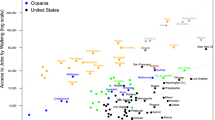Abstract
Los Angeles is well known around the world as an automobile-oriented low density community, yet recent transportation policies have emphasized greater capital investment in rail transportation than in highways, and recent policies have attempted to discourage automobile usage through transportation demand management. While these policies have accomplished small shifts toward public transport and somewhat lower dependence upon singly occupied automobilies for work commuting, the financial costs of these policy changes has been very large in relation to their benefits. Proper pricing of transportation alternatives, more creative use of new and emerging transportation technologies, and the provision of many more opportunities for simpler private sector transport services, would all appear to be more promising as cost-effective approaches to coping with congestion in Los Angeles than the current regional transportation policies.
Similar content being viewed by others
References
Adler S (1987) Why BART but no LART? The Political Economy of Rail Rapid Transit Planning in the Los Angeles and San Francisco Metropolitan Areas, 1945–57.Planning Perspectives 2: 149–174.
Collier C, & Christiansen T (1992)State of the Commute, 1992. Los Angeles: Commuter Transportation Services, Inc.
Commuter Transportation Services, Inc. (1993)Survey Conducted Among Metrolink Riders, March.
Driver R (1992) Transit construction costs. Unpublished Term Paper, Graduate School of Architecture and Urban Planning, UCLA.
Earnst & Young (1992)South Coast Air Quality Management District Regulation XV Cost Survey. Los Angeles, August.
Giuliano G, Hwang K & Wachs M (1993) Mandatory trip reduction in Southern California: First year results.Transportation Research A 27A (2): 125–137.
Giuliano G & Wachs M (1992) Transportation demand management as part of growth management. In Stein J (ed.)Growth Management: The Planning Challenge of the 1990s. Sage Publications, 1992, Chapter 10.
Gordon P, Richardson HW & Jun M-J (1991) The commuting paradox: Evidence from the top twenty.Journal of the American Planning Association 57 (4 Autumn): 416–419.
Hart T (1992) Transport, the urban pattern and regional change, 1960–2010.Urban Studies 29(3/4): 483–503.
Los Angeles County Transportation Commission (1992) Congestion management program for Los Angeles County. Final Draft, Revised September.
Moore II, JE (1993) Ridership and cost on the Long Beach — Los Angeles Blue Line Train.Transportation Research A 27A (2): 139–152.
Newman PG & Kenworthy JR (1989) Gasoline consumption and cities: A comparison of U.S. cities with a global survey.Journal of the American Planning Association 55 (1 Winter): 24–37.
Pisarski A (1992)Travel Behavior Issues in the 90s Advance Copy. Washington: Federal Highway Administration, U.S. Department of Transportation, July.
Pisarski A (1992a)New Perspectives in Commuting Washington: Federal Highway Administration, US. Department of Transportation, July.
Pucher J (1988) Urban travel Behavior as the outcome of public policy: The example of modal split in Western Europe and North America.Journal of the American Planning Association 54 (4 Autumn): 509–520.
Taylor BD (1992)When finance leads planning: The influence of public finance on transportation planning and policy in California Doctoral Dissertation, Graduate School of Architecture and Urban Planning, University of California, Los Angeles.
Wachs M (1993) Modernity and power as constant images in the evolution of the Los Angeles transportation system. Working Paper, Lewis Center for Regional Policy Studies.
Wachs M (1984) Autos, transit, and the sprawl of Los Angeles: The 1920.Journal of the American Planning Association 50 (3) summer): 297–310.
Wachs M & Giuliano G (1992) Employee transportation coordinators: A new profession in Southern California.Transportation Quarterly 46 (3): 411–427.
Webber MW (1992) The Joys of automobility. In: Wachs M & Crawford M (eds)The Car and the City: The Automobile, The Built Environment, and Daily Life (pp 274–284). Ann Arbor: University of Michigan Press, 1992.
Author information
Authors and Affiliations
Rights and permissions
About this article
Cite this article
Wachs, M. Learning from Los Angeles: transport, urban form, and air quality. Transportation 20, 329–354 (1993). https://doi.org/10.1007/BF01100463
Accepted:
Issue Date:
DOI: https://doi.org/10.1007/BF01100463




